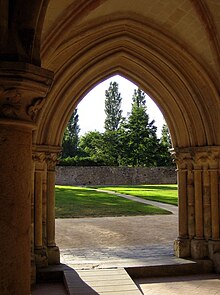L'Épau Abbey
| L'Épau Abbey | |
|---|---|

Entrance to the Chapter House
|
|
| Country | France |
| Denomination | Cistercians |
| History | |
| Founded | 1229 |
| Founder(s) | Berengaria of Navarre |
L'Épau Abbey (French: Abbaye de l'Épau) is a former Cistercian abbey founded by Queen Berengaria in 1229. It is located on the outskirts of the city of Le Mans, on the left bank of the Huisne, adjoining the town of Yvré-l'Évêque. The abbey was suppressed in the French Revolution. The surviving buildings came close to destruction on several occasions, but their preservation was finally assured in 1958 by the General Council of the Sarthe department.
Perseigne Abbey, built within the confines of Norman Maine by the powerful William III of Bellême, can be considered the oldest Cistercian abbey in Maine. It was built in 1145, and is today situated in the commune of Neufchâtel-en-Saosnois. All that remains of it today is a section of wall. During the second millennium, Le Mans saw the construction of several abbeys. Religious faith was booming in the town: The renowned La Couture abbey was built, as were the Saint-Pierre, Saint-Paul and Saint-Vincent abbeys. Mostly, the abbeys were built in privileged areas in the heart of the forest. In 1199, Queen Berengaria was beside herself with grief. Her husband, Richard the Lionheart had succumbed to his wounds in a crossbow battle at Châlus in Haute-Vienne. The Queen was removed from power in Maine but settled among the Plantagenet dynasty in 1204. She became a dowager. In addition, she began to spend all of her time at the Palace of the Count of Maine. Legend has it that the Queen found asylum, but not happiness, in the town. Certain local government figures, in cohorts with Aliénor d'Aquitaine or John Lackland, constantly waged battle with the Queen, trying to steal the inheritance left to her by Philippe Auguste. Only after 26 years in exile did the Queen, aged 59, decide to found an abbey.
Saint-Benoit rules maintained that an abbey built outwith the city limits should respect the obligations of spiritual sanctuary. However, the Queen elected to have the abbey built between town and forest, at the city limits of Le Mans. The Queen built it for her own salvation. Both history and legend suggest that this abbey may also have been built to redeem the fortunes of Plantagenet Kings. On 25 March 1229, the Queen ordered the Citeaux monks to begin construction of Notre-Dame-de-l'Epau. Furthermore, the Queen was a benefactor of this order. The decision to choose monks residing locally was not left to chance. The Queen was also a great friend of confidant Adam de Perseigne, priest at the monastery of the same name and long time confidant of Richard the Lionheart. Father of the Queen, Sanche VI, himself founded the abbey at Oliva in 1140.
...
Wikipedia
